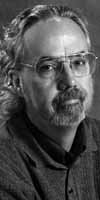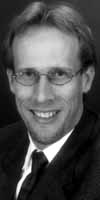
DJC.COM
March 2, 2006
Biotechs differ in needs for space and power
Sparling

Gullstad
|

Thrun
|
Such challenges resulted in two unique engineering approaches for the William H. Foege bioengineering and genome sciences building at the University of Washington, scheduled to open later this year.
The building's two adjacent wings look similar on the outside and share the same electrical power system. However, bringing the bioengineering and genome sciences departments together was an experiment in itself, as their programs (and electrical needs) are quite different.
The genome department desired flexibility to change spaces as projects ebb and flow, while the bioengineering department required a more traditional lab space with dedicated wet labs located on each level. The needs for a vivarium, computational server room and the ability to support new grant programs were all weighed in the design of the electrical system.
Even the way scientists work (bioengineers preferred support office suites next to the labs, while genome researchers desired offices inside the labs) was a major consideration.
While the research conducted by these departments required two unique solutions for lab spaces, reliability was the common goal that guided design on this project.
The last 10 feet
Both fixed and mobile lab spaces support the research that goes on in each building.
Although the departments required a different approach in actual lab style, there is a common flexibility in the electrical capacity that permits minor changes when larger physical remodels need to occur. Apart from the last 10 feet to the work station, the electrical infrastructure for both wings is remarkably similar.
Fixed benches in the bioengineering wing have hard-wired (more permanent) electrical connections, and are ideal for this department's smaller project teams.
These benches are located either against the wall or in an "island" formation, with utility chases that run the length of the bench and feed power and communications connections. Any changes to equipment connections require an electrical contractor to reconfigure from the ceiling.
The genome sciences department has a mobile system in which all surfaces are on wheels and can easily be rolled in and out to support changing programs.
These programs typically have larger project teams with multidisciplinary researchers. There is minimum fixed casework in the lab spaces. A continuous open space ("ghost corridor") is created on each level by modular furniture that attaches to utility drops from the ceiling.
This flexibility permits easy reconfiguration of floor space, and is vital to support the ever-changing grant research programs through the genome department. Electrical outlets can be easily unplugged and reconnected in the new location by department staff, eliminating the need to bring in an electrician for small furniture relocations.
Keeping the power on
The genome department, which was added during design of the bioengineering facility, increased the number of electrical unit substations (main switchboards) from one to three, and required the use of larger transformers than the school typically installs at other science facilities on campus.
The wings have a common electrical system with one main electrical room and a generator that serves both wings, including the vivarium, where the temperature is regulated carefully.
The unit substations are connected with "tie" circuit breakers that allow any two substations to provide power to the third substation in the event of a loss of one of the transformers or feeders.
The substations are fed from three different primary power feeders and arranged in a "spot network" configuration for extra reliability, similar to the nearby UW Medical Center. This allows for complex but quick switching capabilities between primary sources should one fail.
The 1.5-megawatt standby generator provides reliable backup power to the critical lab loads and other department-specific requirements. The life-safety systems in the building are fed from a separate automatic transfer switch to limit potential outages to those systems.
Determining which equipment would be on the generator was also a concern for the users. In response to inquiries from the university about fume hood power and reliability, engineers conducted a small survey of schools around the country to gauge how those campuses provide emergency power to lab buildings, and specifically to fume hoods.
The results were surprising — Seattle and the other cities do not mandate emergency power to the fume hoods. The majority of the peer institutions (and now the Foege Building) do provide backup power to the fume hoods to ensure that any potentially damaging vapors are exhausted should a loss of power occur during research.
High-power server farm
Computational servers are another critical process for genome sciences researchers. These servers act as number crunchers that help model the building blocks of proteins and other processes. Individual researchers require a specific number of "nodes" in this server farm to perform the process operation needed for their experiments.
Each node is effectively a dual-processor PC mounted in a rack. The electrical system in the genome science wing is designed to carry 1,200 such nodes.
This staggering total provides for over 0.5-megawatt of power for computational purposes alone. It is a modular system, so it will begin with what the initial users need and expand with new requirements as new researchers are added.
Engineers also installed internal reradiating systems to ensure the radios used by maintenance workers and emergency medical personnel will operate reliably when they communicate from building to building.
The Foege Building fosters collaboration among scientists, with installation of access points for future wireless communications. Working within their own areas of specialty, the bioengineering and genome sciences departments hope to expand collaborations in areas such as biosynthesis, molecular structure and protein interactions.
A flexible, reliable electrical system customized for each department's diverse research will help achieve that goal.
Bill Gullstad is an associate and Troy Thrun is a principal at Sparling, an electrical engineering and technology consulting firm with offices in Seattle and Portland.
Other Stories:
- Biotech developers are going green
- WSU looks to ramp up biotech development
- Public spaces put a friendly face on lab building
- UW's first DBOM building almost done
Copyright ©2009 Seattle Daily Journal and DJC.COM.
Comments? Questions? Contact us.